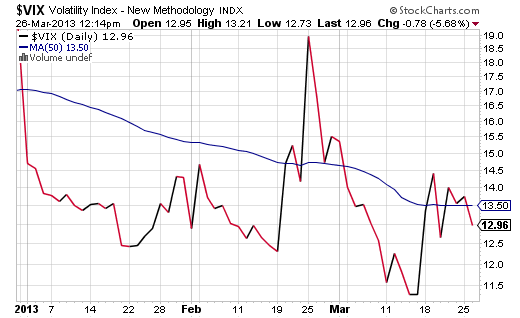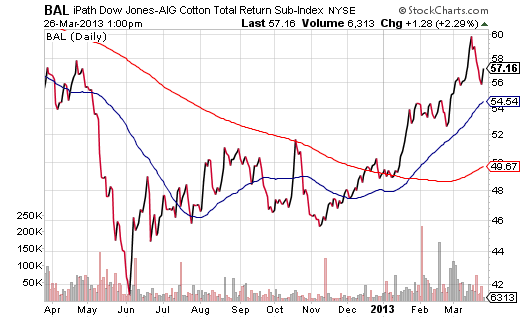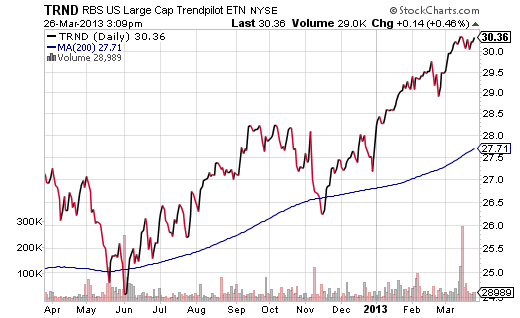The warning signs for a stock market pullback are everywhere. Historically, a 17% move over 17 weeks (sans correction) is not only substantive in size, it may be “long in the tooth.” What’s more, the ultra-low levels on the CBOE S&P 500 Volatility Index (VIX) demonstrate complacency.
Seasonal patterns are another concern. Specifically, a wide variety of economic reports notched better-than-expected results prior to the previous three springtime sell-offs. Could history repeat itself for a fourth consecutive year? I’m not so sure how much faith I would put in “Sell-In-May-And-Go-Away.”
Nevertheless, every lengthy run-up tends to slam into profit-taking and/or the “unforeseen.” Moreover, the most troublesome aspect of today’s runaway U.S. stock train is the lack of participation from the emerging markets.
There are, however, a few stories that have flown under the radar. “Outside the box” may not even begin to describe them. (Note: These are not recommendations; rather, they are observations that may help the reader make a decision for his/her portfolio.)
1. iPath DJ UBS Cotton Total Return (BAL). Both the fundamentals and the technicals for cotton are starting to look rather cheerful. Fundamentally, China plans to stockpile the soft commodity in 2013 which is likely to encourage worldwide cotton demand/importing. Meanwhile, U.S. farmers have already decided to plant nearly 20% less fiber. Less supply worldwide implies a strong possibility of price appreciation.
Technically, the 50-day trendline for BAL crossed above its 200-day (i.e., bullish “golden cross) in February. The current price is roughly 33% lower than it was 2 years ago, leaving ample room for price gains. 
2. RBS US Large Cap Trend Pilot ETN (TRND). I wondered how long it might take for a basic trend-following concept to work its way up to $100M in AUM. Although TRND has received very little publicity, it has made it to the “here-to-stay” ranks in a little more than 2 years time. More importantly, TRND does not try to outwit, outsmart and outlast. TRND is fully invested in the S&P 500 if the index price is above its historical 200-day simple moving average for 5 consecutive days; conversely, if the price of the S&P 500 is below its historical 200-day for 5 consecutive days, TRND invests 100% in “cash” via an index for the 3-month U.S. Treasury bill.
Trend-following with the long-term moving average has its flaws; most notably, it tends to be late to a bullish party. On the other hand, it nearly always keeps the powder dry and significantly minimizes the downside risk of bear markets. TRND may not have a long history as an exchange-traded tracker, yet it is proving to be an effective risk-adjusted investment vehicle. 
3. PowerShares Emerging Markets Technical Leaders (PIE). Most emerging market stock ETFs are heavy on the BRIC (Brazil, Russia, India China). The problem? If you are hanging with the largest emerging economies in 2013, you’ve been losing money. Note: Think Vanguard Emerging Markets (VWO).
In contrast, PIE uses relative strength when conducting its quarterly rebalancing. With Thailand, Indonesia and Mexico having had the best momentum in the most recent quarter, the continuation of that momentum has led to phenomenal gains in Q1 of 2013. In spite of a tendency by some commentators to overplay the fundamental valuation card, individual investors should not underestimate the impact that technical analysis is having on successful portfolios.
Disclosure: Gary Gordon, MS, CFP is the president of Pacific Park Financial, Inc., a Registered Investment Adviser with the SEC. Gary Gordon, Pacific Park Financial, Inc, and/or its clients may hold positions in the ETFs, mutual funds, and/or any investment asset mentioned above. The commentary does not constitute individualized investment advice. The opinions offered herein are not personalized recommendations to buy, sell or hold securities. At times, issuers of exchange-traded products compensate Pacific Park Financial, Inc. or its subsidiaries for advertising at the ETF Expert web site. ETF Expert content is created independently of any advertising relationships.
- English (UK)
- English (India)
- English (Canada)
- English (Australia)
- English (South Africa)
- English (Philippines)
- English (Nigeria)
- Deutsch
- Español (España)
- Español (México)
- Français
- Italiano
- Nederlands
- Português (Portugal)
- Polski
- Português (Brasil)
- Русский
- Türkçe
- العربية
- Ελληνικά
- Svenska
- Suomi
- עברית
- 日本語
- 한국어
- 简体中文
- 繁體中文
- Bahasa Indonesia
- Bahasa Melayu
- ไทย
- Tiếng Việt
- हिंदी
The Exchange-Traded Road Less Traveled
Published 03/27/2013, 02:55 AM
The Exchange-Traded Road Less Traveled
Latest comments
Loading next article…
Install Our App
Risk Disclosure: Trading in financial instruments and/or cryptocurrencies involves high risks including the risk of losing some, or all, of your investment amount, and may not be suitable for all investors. Prices of cryptocurrencies are extremely volatile and may be affected by external factors such as financial, regulatory or political events. Trading on margin increases the financial risks.
Before deciding to trade in financial instrument or cryptocurrencies you should be fully informed of the risks and costs associated with trading the financial markets, carefully consider your investment objectives, level of experience, and risk appetite, and seek professional advice where needed.
Fusion Media would like to remind you that the data contained in this website is not necessarily real-time nor accurate. The data and prices on the website are not necessarily provided by any market or exchange, but may be provided by market makers, and so prices may not be accurate and may differ from the actual price at any given market, meaning prices are indicative and not appropriate for trading purposes. Fusion Media and any provider of the data contained in this website will not accept liability for any loss or damage as a result of your trading, or your reliance on the information contained within this website.
It is prohibited to use, store, reproduce, display, modify, transmit or distribute the data contained in this website without the explicit prior written permission of Fusion Media and/or the data provider. All intellectual property rights are reserved by the providers and/or the exchange providing the data contained in this website.
Fusion Media may be compensated by the advertisers that appear on the website, based on your interaction with the advertisements or advertisers.
Before deciding to trade in financial instrument or cryptocurrencies you should be fully informed of the risks and costs associated with trading the financial markets, carefully consider your investment objectives, level of experience, and risk appetite, and seek professional advice where needed.
Fusion Media would like to remind you that the data contained in this website is not necessarily real-time nor accurate. The data and prices on the website are not necessarily provided by any market or exchange, but may be provided by market makers, and so prices may not be accurate and may differ from the actual price at any given market, meaning prices are indicative and not appropriate for trading purposes. Fusion Media and any provider of the data contained in this website will not accept liability for any loss or damage as a result of your trading, or your reliance on the information contained within this website.
It is prohibited to use, store, reproduce, display, modify, transmit or distribute the data contained in this website without the explicit prior written permission of Fusion Media and/or the data provider. All intellectual property rights are reserved by the providers and/or the exchange providing the data contained in this website.
Fusion Media may be compensated by the advertisers that appear on the website, based on your interaction with the advertisements or advertisers.
© 2007-2025 - Fusion Media Limited. All Rights Reserved.
